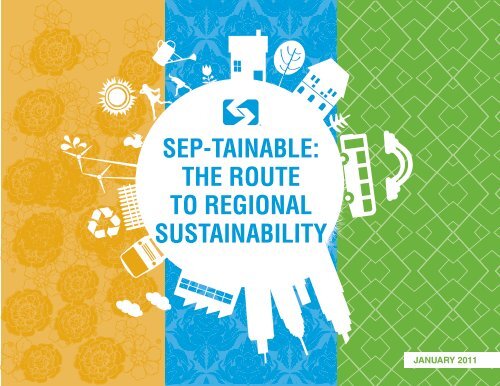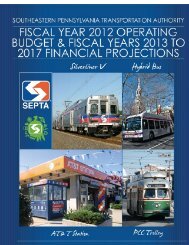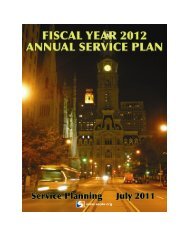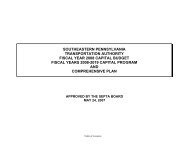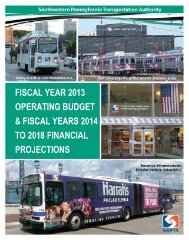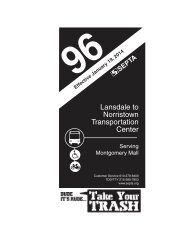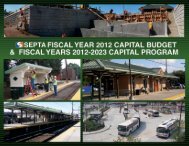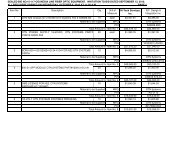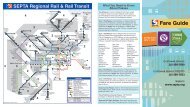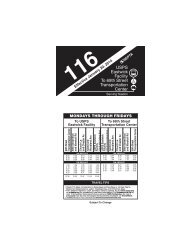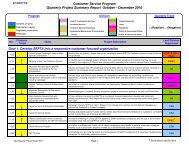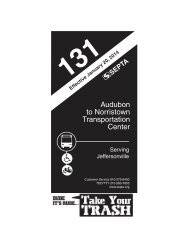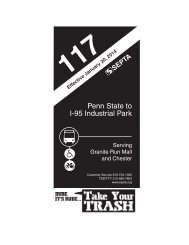The Route to Regional Sustainability - Septa
The Route to Regional Sustainability - Septa
The Route to Regional Sustainability - Septa
Create successful ePaper yourself
Turn your PDF publications into a flip-book with our unique Google optimized e-Paper software.
Sep-tainable:<br />
<strong>The</strong> <strong>Route</strong><br />
<strong>to</strong> regional<br />
sustainability<br />
January 2011
<strong>Sustainability</strong> in a “Fast and<br />
Ever-Changing World”<br />
A Letter From the General Manager<br />
When SEPTA bought its first hybrid-electric bus in 2002, it demonstrated<br />
what many of us at SEPTA believed for a long time—that the future<br />
of transit depends on its ability <strong>to</strong> provide the most efficient means of<br />
getting <strong>to</strong> where you want <strong>to</strong> go.<br />
Eight years later, we have come <strong>to</strong> understand that the real benefits<br />
of that purchase – and of transit in general – extends well beyond<br />
fuel economy. SEPTA empowers residents <strong>to</strong> achieve financial<br />
independence <strong>to</strong> develop healthy lifestyles, and <strong>to</strong> reside in clean and<br />
livable communities. For these reasons, we believe SEPTA is the key <strong>to</strong><br />
our region’s long-term sustainability.<br />
<strong>The</strong>re has never been a better time <strong>to</strong> plan for sustainability. Accelerating<br />
economic turmoil and environmental degradation have <strong>to</strong>uched every<br />
corner of the world. Concerns over resource scarcity, financial stability,<br />
and national security have become heightened as a sense of uncertainty<br />
continues <strong>to</strong> cloud recovery.<br />
At SEPTA, we <strong>to</strong>o find ourselves in a position of uncertainty. Lingering<br />
regional unemployment has limited ridership growth and state<br />
transportation capital funding has been cut by $110 million. <strong>The</strong> resulting<br />
constraints have forced cutbacks on previously-planned projects funded<br />
through the operating and capital budgets.<br />
<strong>The</strong> economic, social, and environmental challenges facing SEPTA as an<br />
organization, and Greater Philadelphia as a region, are far <strong>to</strong>o important<br />
<strong>to</strong> depend on external influences <strong>to</strong> determine our fate.<br />
SEP-TAinable is our plan for shaping this destiny. By proactively<br />
mitigating environmental impacts, building a versatile workforce, and<br />
ensuring fiscal stability, SEPTA will become a more competitive transit<br />
system and serve as an attractive mobility alternative. A more competitive<br />
transit system, in turn, will improve environmental stewardship, help <strong>to</strong><br />
build livable communities, and increase economic prosperity across<br />
Greater Philadelphia. In other words, by becoming more sustainable<br />
now, SEPTA will be prepared for – and indeed help create – a more<br />
environmentally, socially, and economically sustainable future for the<br />
entire region.<br />
On behalf of the SEPTA Board, I am pleased <strong>to</strong> share SEP-TAINABLE<br />
with you. Of course, a plan is only the first step in a long process of<br />
implementation. For that, we will be looking <strong>to</strong> you for support. But<br />
the leadership already exhibited across this region in implementing<br />
sustainability agendas gives me great hope that by 2015, we will have<br />
accomplished most, if not all, of the ambitious initiatives included in<br />
this program. Most importantly, our progress will contribute <strong>to</strong> making<br />
Greater Philadelphia the most sustainable, mobile, and competitive<br />
region in America.<br />
Joseph M. Casey<br />
General Manager<br />
SEPTA cannot afford <strong>to</strong> wait for funding fixes or economic recovery. <strong>The</strong><br />
region cannot afford further decline of its transit infrastructure.<br />
1
Introduction<br />
Greater Philadelphia grew up around its transit system. From its famed<br />
city streetcars <strong>to</strong> his<strong>to</strong>ric Main Line communities, the region’s his<strong>to</strong>ry<br />
has been enriched by a legacy left by generations of investments in<br />
public transportation.<br />
In the second half of the 20th century, the world changed. <strong>The</strong> advent of<br />
the interstate highway system and an era of low energy prices, combined<br />
with policies that encouraged decentralized growth and sprawl, made<br />
public transit – and many of the communities it served – less competitive.<br />
<strong>The</strong> private companies that collectively owned and operated the region’s<br />
transit infrastructure went bankrupt. With generations of investments at<br />
risk, the Southeastern Pennsylvania Transportation Authority (SEPTA)<br />
was created <strong>to</strong> inherit and manage what remained. For nearly a halfcentury,<br />
SEPTA has done exactly that: methodically piece back <strong>to</strong>gether<br />
and rebuild Greater Philadelphia’s transit system.<br />
This plan is about proactively changing this dynamic – reinvigorating<br />
SEPTA’s role as an economic, social, and environmental sustainability<br />
solution for the region. Greater Philadelphia’s development could not have<br />
occurred without transit. Its rebirth as a world-class region will require<br />
reinvestment in its assets. This plan represents SEPTA’s commitment <strong>to</strong><br />
do its part by becoming more sustainable in its own right, and <strong>to</strong> actively<br />
partner with stakeholders <strong>to</strong> build a more sustainable region. In so doing,<br />
SEP-TAinable is a framework <strong>to</strong> ensure that for SEPTA and Greater<br />
Philadelphia, the best days are yet <strong>to</strong> come.<br />
Now, the world is changing again. Increasing resource scarcity, societal<br />
changes, and 21st-century policy shifts have renewed an appreciation<br />
of transit’s value in promoting economic prosperity, social equity,<br />
environmental stewardship, and enhanced quality of life. <strong>The</strong> system<br />
SEPTA inherited, once considered obsolete, is increasingly receiving<br />
due recognition as the backbone of future regional sustainability.<br />
But SEPTA’s presence alone does not guarantee a sustainable region.<br />
Investments made by previous generations have left Greater Philadelphia<br />
with a far-reaching transit system that is the envy of many other regions.<br />
<strong>The</strong> return on these investments is a region whose gross metropolitan<br />
product is the seventh largest in the United States. And yet, more recent<br />
decades of underinvestment have eaten away at what once was – and<br />
again could be – a world-class transit system.<br />
million weekday passenger<br />
trips<br />
2
<strong>Sustainability</strong> at SEPTA<br />
Organizational Perspective<br />
For SEPTA, sustainability is not only about “going green.” It is, at its core,<br />
about becoming more competitive. It is about engaging stakeholders<br />
and thinking comprehensively, about breaking down decision-making<br />
silos and taking the long-term view <strong>to</strong> consider the lifecycle costs and<br />
benefits of strategic investments. For a quasi-public organization like<br />
SEPTA, there is an additional layer of responsibility – <strong>to</strong> integrate and<br />
balance broader economic, social, and environmental concerns in<strong>to</strong><br />
decision-making processes.<br />
In short: sustainability is about developing the ongoing capacity <strong>to</strong><br />
endure. For SEPTA, this is an institutional imperative. Over the years,<br />
seemingly perpetual financial crises have forced significant cutbacks in<br />
vital organizational functions. Newfound stability had, in recent years,<br />
momentarily reversed that trend. But new challenges have arisen, and<br />
SEPTA once again has been thrust in<strong>to</strong> a vulnerable financial position.<br />
Given this challenging operating environment, sustainability for SEPTA<br />
is, above all else, about retaking control of its future. While recent events<br />
have clearly illustrated SEPTA’s certain dependency on external fac<strong>to</strong>rs,<br />
crises will come and go. Proactive sustainability planning will ensure that<br />
SEPTA is prepared <strong>to</strong> adapt fluidly <strong>to</strong> whatever challenges may arise.<br />
<strong>Regional</strong> Perspective<br />
For the region, SEPTA’s role as a sustainability solution has become<br />
even more imperative due <strong>to</strong> sprawling development patterns throughout<br />
its service area. <strong>The</strong> Delaware Valley <strong>Regional</strong> Planning Commission<br />
(DVRPC) highlighted the impact of this trend in its most recent longrange<br />
plan: Connections: <strong>The</strong> <strong>Regional</strong> Plan for a Sustainable Future.<br />
In Connections DVRPC paints a troubling picture of population and<br />
land use trends. Between 1930 and 1970, the region’s land developed<br />
at three-and-a-half-times the rate of population growth. Between 1970<br />
and 2005, the land development rate actually accelerated – <strong>to</strong> seven<br />
times the rate of population growth.<br />
3<br />
<strong>The</strong> implications of sprawl are far-reaching. Most relevant <strong>to</strong> SEPTA is that<br />
the region’s radial rail transit network, which reached maturity well before<br />
20th century au<strong>to</strong>-oriented development patterns had begun <strong>to</strong> erode the<br />
region’s dense urban core, adequately serves a shrinking share of the<br />
region’s population. Decentralized population and employment centers<br />
increasingly limit transit options and access, causing a shift <strong>to</strong> increasing<br />
au<strong>to</strong>mobile use. According <strong>to</strong> DVRPC, between 1980 and 2000, the number<br />
of au<strong>to</strong>mobiles in the region increased by 37 percent and the number of<br />
VMT increased by 52 percent, despite a population increase of only seven<br />
percent. <strong>The</strong> end result is a region whose average commute time ranks<br />
among the longest in the United States.<br />
SEPTA has adapted <strong>to</strong> the region’s sprawling land use patterns with<br />
extensive bus transit services and parking facilities <strong>to</strong> complement its rail<br />
network. Still, transit ridership steadily declined between 1990 and 2005,<br />
as au<strong>to</strong>-oriented land uses continued <strong>to</strong> strain SEPTA’s competitiveness<br />
as a regional transportation mode of choice. And despite a more recent<br />
rebound in ridership, transit’s regional mode share remains more than 50<br />
percent below its peak mid-20th century levels.<br />
80%<br />
70%<br />
60%<br />
50%<br />
40%<br />
30%<br />
20%<br />
10%<br />
0%<br />
-10%<br />
-20%<br />
VMT vs. Car Ownership, Population, and Transit<br />
Ridership (1980-2007)<br />
1980 1990 2000 2005 2007<br />
Source: DVRPC<br />
Annual VMT Vehicles Employment Population Transit<br />
Ridership
REGIONAL COMMUTE TO WORK MODE SHARE (1980-2007)<br />
100%<br />
90%<br />
80%<br />
70%<br />
60%<br />
50%<br />
40%<br />
30%<br />
20%<br />
10%<br />
0%<br />
1980 1990 2000 2005 2007<br />
Looking forward, the impacts of sprawl will be exacerbated by a<br />
widespread aging of Greater Philadelphia’s population, which DVRPC<br />
forecasts <strong>to</strong> accelerate between now and 2025, when one in five of the<br />
region’s residents will be over the age of 65. DVRPC expects the aging<br />
trend <strong>to</strong> be especially strong in suburban communities, where a large<br />
proportion of “baby boomers” will “age-in-place.” <strong>The</strong> limited transit access<br />
in many suburban and exurban communities could significantly constrain<br />
the mobility of a rapidly growing segment of the region’s aging population.<br />
Recognizing the vital linkage between mobility and land use, DVRPC’s<br />
Connections plan investigated three “what if” scenarios for future growth:<br />
+<br />
+<br />
+<br />
Drive Alone Carpooled Public<br />
Transportation<br />
Pedestrian<br />
Commuters<br />
Source: DVRPC<br />
Worked<br />
at Home<br />
Recentralization: return of population and jobs <strong>to</strong> the region’s<br />
currently developed areas<br />
Trend: DVRPC Board-adopted population and employment<br />
forecasts<br />
Sprawl: acceleration of development in<strong>to</strong> currently undeveloped<br />
outlying areas<br />
4<br />
<strong>The</strong> analysis, which forecasts the same gross population and employment<br />
for each scenario, found that in 2035 the recentralization scenario could<br />
add more than 190,000 new households and 257,000 new jobs in areas<br />
with existing transit access. Alternatively, the sprawl scenario would<br />
decrease transit access by 159,000 new households and 83,500 new<br />
jobs. By focusing development around transit nodes, the recentralization<br />
scenario could increase transit ridership by 14 percent, reducing regional<br />
VMT by 1.7 billion over trend.<br />
SEPTA’s competitiveness as a regional transportation mode of choice will<br />
be shaped in large part by how the region’s future development patterns<br />
play out. Recentralized development would improve transit accessibility,<br />
promote ridership growth, and, as DVRPC concludes, support the many<br />
associated economic, social, and environmental co-benefits:<br />
“Based on analysis of different scenario impacts <strong>to</strong> land<br />
use, transportation, the environment, and economic<br />
competitiveness, the Recentralization scenario offers the<br />
best solutions for a sustainable future. This scenario offers<br />
a superior quality of life by increasing mobility choices,<br />
preserving more open space, and reducing demand for<br />
energy, which lowers household and business expenses.<br />
Denser, more compact, mixed land uses can shorten<br />
distances between origins and destinations, which<br />
encourages alternative forms of transportation. Less energy<br />
use helps <strong>to</strong> reduce CO2 emissions, making the region<br />
more sustainable. By spending less on replicating existing<br />
infrastructure, more money can be invested in green and<br />
energy-efficient technologies or alternative fuels. This, in<br />
turn, will help ensure that the region remains economically<br />
competitive in a fast and ever-changing world.”
SEPTA’s <strong>Sustainability</strong> Program<br />
Transit agencies, thrust in<strong>to</strong> this fast and ever-changing world, need <strong>to</strong><br />
adapt. Agencies that plan ahead will be prepared when opportunities<br />
arise <strong>to</strong> become more sustainable. Those that don’t will fall behind.<br />
SEP-TAinable is a comprehensive framework for SEPTA <strong>to</strong> rise <strong>to</strong><br />
this occasion, establishing readiness for the challenges and moments<br />
of opportunity as they arise. This task is bigger than SEPTA; ultimately,<br />
SEPTA’s sustainability and the sustainability of the region are inextricably<br />
linked. For this reason, SEP-TAinable has been built upon extensive<br />
outreach and engagement with regional stakeholders. <strong>The</strong> 12 targets<br />
that emerged from this process represent tangible goals for SEPTA <strong>to</strong><br />
reach by 2015 <strong>to</strong> advance sustainability at SEPTA and throughout its<br />
service region.<br />
OVERVIEW: A THREE-PRONGED APPROACH<br />
SEPTA’s approach <strong>to</strong> sustainability is based on the triple bot<strong>to</strong>m line<br />
– accounting for economic, social, and environmental organizational<br />
needs and regional opportunities. SEPTA will use this three-pronged<br />
approach <strong>to</strong> drive sustainable decision-making at SEPTA and for<br />
partnering <strong>to</strong> build a more sustainable region.<br />
Economic<br />
SEPTA is an economic catalyst. As one of the region’s largest employers,<br />
SEPTA supports tens of thousands of jobs and pumps hundreds of<br />
millions of dollars in<strong>to</strong> the regional economy each year. Just as important<br />
is our vast service network that connects Greater Philadelphia <strong>to</strong> places<br />
where people live, work, and play. Moving more than 400,000 people<br />
each weekday, SEPTA keeps the regional economy moving.<br />
Social<br />
SEPTA helps <strong>to</strong> build livable communities. An expansive regional transit<br />
network supports the existence and creation of compact, high-quality,<br />
and affordable transit-oriented development. Reverse commute and<br />
employment programs ensure equal access <strong>to</strong> this network for all.<br />
Environmental<br />
SEPTA advances environmental stewardship. By displacing greenhouse<br />
gas emissions, its system and services provide a mobility alternative<br />
that improves air quality and shrinks our carbon footprint, moving the<br />
region <strong>to</strong>wards a more energy efficient future.<br />
SEPTA’s sustainability objectives, targets, and initiatives are organized<br />
under these three interconnected pillars, where SEPTA has already<br />
taken great strides <strong>to</strong> advance regional sustainability. This plan places<br />
SEPTA’s existing efforts within a comprehensive strategy for expanding<br />
sustainability as a policy driver and key decision-making fac<strong>to</strong>r across<br />
the organization.<br />
SEPTA’s<br />
Comprehensive<br />
Approach <strong>to</strong><br />
<strong>Sustainability</strong><br />
• Advanced Stewardship<br />
• Footprint Reducing<br />
5
INTEGRATION WITH SEPTA’S FIVE-YEAR<br />
STRATEGIC BUSINESS PLAN<br />
<strong>Sustainability</strong> is a natural fit as a core objective within SEPTA’s Five-Year<br />
Strategic Business Plan, which set forth a vision for SEPTA <strong>to</strong> become<br />
the region’s premier choice for transportation by:<br />
+ Connecting the region for integrated mobility<br />
+ Sustaining the environment and preserving the system for future<br />
generations<br />
+ Committing <strong>to</strong> continuous improvement and innovation<br />
+ Providing excellent service by a team of dedicated employees<br />
Released in March 2009, the plan highlights sustainability’s<br />
interrelationship with six other strategic focus areas: cus<strong>to</strong>mer service;<br />
safety and security; human capital development; new technologies;<br />
ridership growth; and rebuilding the system. <strong>The</strong> plan elevates<br />
sustainability as a regional imperative for which SEPTA has a leadership<br />
responsibility. SEPTA’s three-pronged approach <strong>to</strong> sustainability is<br />
designed <strong>to</strong> fully integrate with the Strategic Business Plan. Each of the<br />
sustainability plan’s12 goals and targets overlap with SEPTA’s six other<br />
strategic focus areas.<br />
INTEGRATION WITH THE APTA SUSTAINABILITY<br />
COMMITMENT<br />
SEPTA’s sustainability program is also designed <strong>to</strong> fully integrate with<br />
the American Public Transportation Association (APTA) <strong>Sustainability</strong><br />
Commitment. <strong>The</strong> core principles of this commitment are:<br />
+ Making sustainability a part of SEPTA’s strategic<br />
objectives<br />
+ Identifying a sustainability champion within SEPTA coupled with the<br />
proper human and/or financial resources and mandates<br />
6<br />
+<br />
Establishing an outreach program (awareness-raising and<br />
education) on sustainability for all SEPTA staff<br />
+ Undertaking a SEPTA sustainability inven<strong>to</strong>ry<br />
SEPTA’s sustainability goals and targets adapt APTA’s recommended<br />
indica<strong>to</strong>rs <strong>to</strong> meet its own planning purposes. SEPTA intends <strong>to</strong> commit<br />
as a signa<strong>to</strong>ry during plan implementation.<br />
Goals and Initiatives<br />
OVERVIEW<br />
SEP-TAinable is both an evaluation and a challenge. <strong>The</strong> 12 goals<br />
established in the plan are an outgrowth of SEPTA’s Five-Year Strategic<br />
Business Plan, a document that elevated sustainability <strong>to</strong> the forefront of<br />
the organizational agenda. As detailed in the plan, SEPTA has already<br />
taken significant strides <strong>to</strong> improve economic, social, and environmental<br />
performance. Making SEPTA more sustainable will help <strong>to</strong> ensure fiscal<br />
stability, strengthen the workforce, and reduce environmental impacts.<br />
SEPTA will achieve ambitious targets <strong>to</strong>wards each of these goals<br />
through a series of initiatives that build off of SEPTA’s existing efforts<br />
and priorities identified in the business plan.<br />
But, as DVRPC notes in its Connections plan, SEPTA’s sustainability is<br />
as critical <strong>to</strong> the region as it is <strong>to</strong> the organization itself. Decentralized<br />
development patterns and sprawling land-use conditions have created<br />
an economically, socially, and environmentally unsustainable situation<br />
for the region. <strong>The</strong> future of Greater Philadelphia, which is otherwise<br />
poised <strong>to</strong> reemerge as a world-class region, depends on robust transit<br />
that serves as a sustainability solution <strong>to</strong> these present-day challenges.
1: Improve greenhouse gas (GHG)<br />
and criteria air pollutant emissions<br />
performance<br />
Environmental<br />
Target: 5 percent annual improvement through 2015<br />
SEPTA produces GHG emissions from the daily combustion of carbonbased<br />
fuels and purchase of fossil fuel-based electricity. But as a<br />
provider of mass transit, SEPTA also displaces emissions by taking<br />
cars off the road and supporting compact development patterns.<br />
Applying the American Public Transportation Association’s standard<br />
methodology for calculating GHG emissions, the net result of SEPTA’s<br />
GHG impact is a reduction in emissions by a fac<strong>to</strong>r of three – for every<br />
unit of greenhouse gas that SEPTA emits, three units are displaced<br />
throughout the region. SEPTA’s GHG performance is hindered in part<br />
by heavy use of electricity for propulsion, for which GHG emissions are<br />
high compared <strong>to</strong> those of peer transit agencies due <strong>to</strong> the carbonintensive<br />
fuel mix of local electricity generation. As generation continues<br />
<strong>to</strong> become cleaner, SEPTA can grow its position as a net emissions<br />
displacer by reducing its own greenhouse gas emissions along three<br />
metrics: GHG emissions per vehicle mile, per revenue vehicle hour, and<br />
per passenger mile traveled.<br />
SEPTA will achieve its GHG and criteria air pollutant<br />
emissions performance target by undertaking the following<br />
initiatives:<br />
7<br />
+<br />
+<br />
+<br />
+<br />
+<br />
+<br />
Develop climate action plan (CAP)<br />
Continue efforts <strong>to</strong> improve air quality performance<br />
Pursue alternative energy vehicle procurement<br />
Install low-NOx boilers<br />
Complete a vulnerability and risk assessment<br />
Invest in renewable energy
2: Improve water use and pollutant<br />
discharge performance<br />
Target: 10 percent improvement by 2015<br />
SEPTA’s current water use is metered at over 300 separate locations,<br />
providing a useful—but incomplete—picture of water consumption<br />
throughout the system. Between 2006 and 2009, consumption costs at<br />
these stations, shops, garages, and administrative locations increased<br />
by an average of 6.7 percent per year <strong>to</strong> the current cost of $1.9 million.<br />
But the nature of water bills is changing, transitioning from a simple<br />
cost of consumption <strong>to</strong> a more comprehensive model that accounts for<br />
a property’s s<strong>to</strong>rmwater runoff. This new price structure gives SEPTA<br />
two areas for improvement: reducing its water consumption and its<br />
impervious surface footprint.<br />
SEPTA will achieve its water use and pollutant discharge<br />
performance target by undertaking the following initiatives:<br />
+<br />
+<br />
+<br />
+<br />
+<br />
+<br />
+<br />
+<br />
+<br />
+<br />
+<br />
+<br />
Track usage systemwide<br />
Evaluate cost-effective opportunities <strong>to</strong> reduce meter size<br />
Install roof rainwater collection systems<br />
Conduct an analysis of water recycling mechanisms on vehicle<br />
washer systems<br />
Capture pumped groundwater from subsurface tunnels<br />
Recycle potable water used <strong>to</strong> cool transformers<br />
Improve s<strong>to</strong>rmwater control and reduce s<strong>to</strong>rmwater runoff<br />
Set a SEPTA agenda for ecosystem and wetlands management<br />
Improve water fixtures and conservation at SEPTA facilities<br />
Retrofit or construct buildings <strong>to</strong> accommodate green roofs<br />
Expand tree planting by partnering with the Pennsylvania<br />
Horticultural Society<br />
Partner with stakeholders <strong>to</strong> protect natural habitats<br />
8<br />
3: Improve energy intensity performance<br />
Target: 10 percent improvement by 2015<br />
SEPTA depends on energy for every aspect of its operations, from<br />
powering railcars and buses <strong>to</strong> heating stations and illuminating track<br />
signals. <strong>The</strong> fuel and power needed <strong>to</strong> move SEPTA’s vehicles and run<br />
its facilities represents eight percent of the agency’s operating budget,<br />
4.5 mmBtu in overall usage. In all, SEPTA’s energy consumption rose<br />
by 1.5 percent between 2006 and 2009, but changes in energy use vary<br />
greatly by sec<strong>to</strong>r. Fuel consumption for building heat, for example, rose<br />
7.6 percent each year over that period, while vehicle energy use grew<br />
by less than one percent annually. Trends in energy consumption can<br />
be tracked against trends in operating performance through the metric<br />
of energy intensity, or consumption per vehicle mile. This breakdown<br />
demonstrates how targeted initiatives, such as greater integration of<br />
hybrid-electric buses, can minimize changes in energy consumption<br />
while enabling SEPTA <strong>to</strong> expand its operations.<br />
SEPTA will achieve its energy intensity performance target<br />
by undertaking the following initiatives:<br />
+ Prioritize energy-efficiency facility projects<br />
+ Adopt “LEED Silver” standards for all new building construction<br />
+ Increase the number of LEED accredited employees<br />
+ Encourage conservation among employees<br />
+ Continue non-revenue fleet management planning efforts<br />
+ Install energy efficient escala<strong>to</strong>rs<br />
+ Install LED Lighting<br />
+ Install lighting motion sensors<br />
+ Replace inefficient HVAC systems <strong>to</strong> save energy<br />
+ Implement wayside energy s<strong>to</strong>rage systems<br />
+ Evaluate the use of more energy-efficient electrical mo<strong>to</strong>rs and<br />
transformers<br />
+ Take advantage of natural lighting and ventilation
4: Reduce and reuse waste<br />
Target: 20 percent waste diversion by 2015<br />
Across the system, SEPTA produces a variety of waste streams ranging<br />
from purely municipal <strong>to</strong> hazardous and non-hazardous industrial<br />
waste. Producing waste, aside from filling landfills and contributing<br />
<strong>to</strong> environmental degradation, comes with a direct cost: the contracts<br />
SEPTA lets for waste removal exceed $1 million annually. For these<br />
reasons, SEPTA is better managing its waste flows through a waste<br />
minimization program at maintenance facilities and through the resale of<br />
scrap materials and waste oil. Still, insufficient data exists <strong>to</strong> adequately<br />
track and manage waste flows.<br />
SEPTA will achieve its waste diversion target by<br />
undertaking the following initiatives:<br />
+<br />
+<br />
+<br />
+<br />
+<br />
+<br />
+<br />
Quantify and track SEPTA’s material flow<br />
Create green procurement policies<br />
Institute systemwide lifecycle analysis (LCA)<br />
Promote SEPTA rider conservation<br />
Use sustainable railroad ties, where possible<br />
Evaluate repair-return-leasing opportunities<br />
Increase contrac<strong>to</strong>r awareness of green standards<br />
Social<br />
Goals<br />
+<br />
Implement a comprehensive recycling program at passenger and<br />
employee facilities<br />
+<br />
+<br />
+<br />
Expand upon a scrap commodity management program<br />
Expand upon a surplus material sales program<br />
Close the loop with the use of recycled materials<br />
9
5: Integrate with livable communities<br />
Target: One transit-oriented development (TOD) project per year<br />
Transit spurred the growth of modern Philadelphia and its suburbs,<br />
populating neighborhoods along trolley routes and creating commuter<br />
rail access <strong>to</strong> undeveloped outlying areas. Today, while development<br />
has moved far beyond the boundaries of public transit, the benefits of<br />
transit-oriented development (TOD) persist. Recent studies show that<br />
residents of transit-served communities have a lower cost of living and<br />
live healthier lifestyles than those who depend on cars for mobility. Rising<br />
transportation costs mean that consumers are once again recognizing<br />
the benefits of living near transit, and developers are building <strong>to</strong> meet<br />
that demand. Although SEPTA is restricted from developing its own<br />
land for commercial activity, the Authority can be proactive in supporting<br />
ongoing TOD projects and in attracting new development near its<br />
facilities. Where new development is not an option, SEPTA can better<br />
integrate with communities by improving its accessibility with other<br />
modes of transportation.<br />
SEPTA will achieve its community-building target by<br />
undertaking the following initiatives:<br />
+<br />
+<br />
Develop a transit-oriented development (TOD) policy<br />
Create a SEPTA TOD portfolio <strong>to</strong> encourage development<br />
+ Leverage Transit Revitalization Investment District (TRID)<br />
opportunities<br />
+ Incorporate affordable housing in<strong>to</strong> official policy<br />
6: Improve access <strong>to</strong> local food<br />
Target: Three new farmers markets on SEPTA property<br />
Transit enables residents <strong>to</strong> live beyond the constraints of their<br />
neighborhood. In many cases, transit’s biggest advantage is that it opens<br />
up distant job markets, but transit also provides access <strong>to</strong> life necessities<br />
such as healthcare and, importantly, food. Low income neighborhoods<br />
often lack access <strong>to</strong> fresh food, creating widespread poor health conditions.<br />
Recognizing that these conditions exist in Philadelphia, Greenworks<br />
Philadelphia, the City’s comprehensive plan <strong>to</strong> turn Philadelphia in<strong>to</strong> the<br />
greenest city in America by 2015, set the citywide target of bringing local<br />
food <strong>to</strong> within 10 minutes of 75 percent of residents. <strong>The</strong> Mayor’s Office of<br />
is currently laying the groundwork for pursuing that goal. As the region’s<br />
primary provider of transit services, SEPTA will play a substantial role<br />
in taking on this challenge. Through a variety of collaborative initiatives,<br />
SEPTA, the City of Philadelphia, DVRPC, and the Food Trust can improve<br />
access <strong>to</strong> fresh food for all residents.<br />
SEPTA will achieve its food access target by undertaking<br />
the following initiatives:<br />
+ Support the City of Philadelphia’s efforts <strong>to</strong> combat “food deserts”<br />
+ Partner with <strong>The</strong> Food Trust <strong>to</strong> create farmers markets at<br />
SEPTA stations<br />
+ Continue Participation in DVRPC’s Food System Study<br />
+ Participate in Fair Food Philly’s Community-Supported<br />
Agriculture program<br />
+<br />
+<br />
+<br />
Increase bike-and-ride visibility<br />
Support the City of Philadelphia and county bicycle goals<br />
Integrate with bike-sharing programs<br />
10
7: Develop a highly-skilled, healthy and<br />
versatile workforce<br />
Target: 50 percent turnover filled from succession pool<br />
SEPTA’s long-term sustainability depends on the versatility and<br />
well-being of its workforce. As one of the most personnel-intensive<br />
organizations in the region, SEPTA must not only look after its current<br />
employees but also plan ahead <strong>to</strong> recruit the next generation of transit<br />
leaders. SEPTA is actively pursuing “succession planning” strategies in<br />
anticipation of the retirement of 50 percent of its mid- and upper-level<br />
management by 2015. Additionally, SEPTA has grown the scope of its<br />
training programs and developed a new employee wellness series that<br />
includes exercise courses, on-site health services, and a newsletter for<br />
healthy lifestyles.<br />
SEPTA will achieve its workforce planning target by<br />
undertaking the following initiatives:<br />
+ Complete comprehensive succession plan on schedule<br />
+ Increase attendance at employee training programs<br />
+ Incorporate sustainability in<strong>to</strong> employee training and wellness<br />
programs<br />
+ Pair workplace safety with sustainability initiatives<br />
+ Strengthen SEPTA internship program<br />
8: Support regional business equity<br />
Target: 10 percent increase in newly-registered DBE firm<br />
success rate by 2015<br />
As a recipient of federally designated capital grant funding, SEPTA<br />
must adhere <strong>to</strong> equitable contracting practices. SEPTA’s substantial<br />
capital budget gives it a strong market power in the region and an<br />
ability <strong>to</strong> have a positive impact on regional business equity by issuing<br />
a portion of its contracts <strong>to</strong> disadvantaged business enterprises<br />
(DBEs), small businesses owned by minorities and women. SEPTA,<br />
in turn, benefits from the growth and development of these firms<br />
and their successful performance working on important projects<br />
throughout the region.<br />
SEPTA will achieve its business equity target by<br />
undertaking the following initiatives:<br />
+<br />
+<br />
+<br />
+<br />
+<br />
+<br />
Au<strong>to</strong>mate enrollment and database management systems<br />
Increase diligence on personal net worth statements<br />
Incorporate sustainability in<strong>to</strong> contrac<strong>to</strong>r education and outreach<br />
Receive federal approval for men<strong>to</strong>r/protégé relationship<br />
Proactively seek out new opportunities <strong>to</strong> recruit firms<br />
Step up contract enforcement<br />
+<br />
Promote volunteerism among all employees<br />
11
9: Increase transit mode share<br />
Target: 10 percent increase in transit unlinked trips per<br />
capita by 2015<br />
Philadelphia ranks fifth among large cities in average commute time,<br />
across an average distance of 18 miles throughout the five-county<br />
region. <strong>The</strong>se miles add up—71 million au<strong>to</strong> vehicle miles were traveled<br />
each day in the service region in 2005, compared <strong>to</strong> just over 4.1<br />
million miles daily on SEPTA. A major organizational goal is <strong>to</strong> improve<br />
SEPTA’s penetration in regional travel against a 2005 benchmark of 86<br />
transit trips taken per regional resident. While expanding the system<br />
is a clear way <strong>to</strong> attract new riders, SEPTA should also consider less<br />
costly programs that grow ridership within the current service area.<br />
SEPTA will achieve its mode share target by undertaking<br />
the following initiatives:<br />
Economic<br />
Goals<br />
+<br />
+<br />
+<br />
+<br />
+<br />
+<br />
Implement New Payment Technologies program<br />
Further improve system safety<br />
Implement one new major service initiative each year<br />
Develop marketing plan <strong>to</strong> increase awareness of system and<br />
services<br />
Develop comprehensive parking vision plan <strong>to</strong> address system<br />
capacity constraints<br />
Plan for an expanded system through long-range planning<br />
12
10: Improve infrastructure state of good<br />
repair<br />
Target: 15 percent proportionate improvement by 2015<br />
While most of Pennsylvania’s infrastructure is in disrepair, a 2010<br />
report by the American Society of Civil Engineers found that the<br />
state’s transit infrastructure was worst of all. SEPTA’s estimated 65<br />
percent state of good repair is an average that includes the rolling<br />
s<strong>to</strong>ck at 85 percent and the bridges at 50 percent. Bringing SEPTA’s<br />
infrastructure, which is among the nation’s most expansive, up <strong>to</strong> a<br />
state of good repair requires targeted investments in the most capitalintensive<br />
portion of SEPTA’s budget. <strong>The</strong> City of Philadelphia set a<br />
goal in its Greenworks plan for achieving an 80 percent state of good<br />
repair its own infrastructure, and SEPTA is striving <strong>to</strong> keep pace with<br />
the City’s recommended goal.<br />
SEPTA will achieve its infrastructure state of good repair<br />
target by undertaking the following initiatives:<br />
+<br />
+<br />
+<br />
+<br />
Implement a transit asset management (TAM) system<br />
Invest in state of good repair projects<br />
Develop capital project pipeline<br />
Pursue alternative funding <strong>to</strong> support state of good repair projects<br />
11: Improve operating expense<br />
performance<br />
Target: 10 percent improvement by 2015<br />
SEPTA regularly moni<strong>to</strong>rs operating performance by a variety of<br />
metrics, most notably the ratio of passenger revenue <strong>to</strong> fully allocated<br />
cost. Performance may also be measured by average operating speed,<br />
useful as a target <strong>to</strong> reduce end-<strong>to</strong>-end trip time and peak vehicle<br />
demand. While SEPTA performs well in many measures of costeffectiveness,<br />
it lags behind its peers in terms of operating speed largely<br />
due <strong>to</strong> the fact that its stations are in many cases situated unusually<br />
close <strong>to</strong>gether. Still, there are ways <strong>to</strong> improve performance despite<br />
the inherited constraints of SEPTA’s system. “Transit First” committees<br />
have been convened <strong>to</strong> explore a variety of ways <strong>to</strong> streamline and<br />
speed up transit routes. Opportunities <strong>to</strong> improve areas of operating<br />
performance that emerge from these committees will be balanced with<br />
SEPTA’s ongoing obligation <strong>to</strong> cus<strong>to</strong>mer service for all ridership groups.<br />
SEPTA will improve operating expense performance by<br />
undertaking the following initiatives:<br />
+ Include non-revenue operations performance in Annual Service<br />
Plan<br />
+ Increase rate of Transit First and vehicle overhaul program<br />
implementation<br />
+ Implement cost-saving recommendations in ancillary reports<br />
+<br />
Recognize employee innovation in cost-saving techniques<br />
13
12: Achieve PA TAC recommended<br />
funding levels<br />
Target: Full funding of PA TAC recommended funding levels<br />
SEPTA recovers less than half of its operating costs from passenger<br />
revenue, and depends on government subsidies for the remainder of<br />
its operating budget and for its entire capital budget. <strong>The</strong> Pennsylvania<br />
Transportation Advisory Committee (PA TAC) noted that continued<br />
underfunding has prevented transportation agencies like SEPTA from<br />
making long-overdue investments in its infrastructure and estimates<br />
that the statewide transit funding shortfall will grow <strong>to</strong> $1.4 billion by<br />
2020. Additionally, the state’s inability <strong>to</strong> <strong>to</strong>ll Interstate 80 has created<br />
a $110 million hole in SEPTA’s FY2011 capital budget and forced the<br />
deferral of 22 capital projects. With allocations from the Pennsylvania<br />
Transportation Trust Fund frozen, SEPTA’s budget shortfall will grow<br />
steadily in<strong>to</strong> the future unless lawmakers identify a sustainable funding<br />
source.<br />
SEPTA will join other Pennsylvania transportation agencies in<br />
achieving full funding by the state and federal governments <strong>to</strong> the levels<br />
recommended by the PA TAC by partnering <strong>to</strong> pursue a comprehensive<br />
legislative agenda.<br />
Program Implementation<br />
SUSTAINABLE MANAGEMENT APPROACHES<br />
SEPTA’s expertise in transit management has allowed for the gradual<br />
fine-tuning of its operations based on industry best practices. This<br />
institutional knowledge has served SEPTA well in its becoming one of<br />
North America’s most efficient and cost-effective transit service providers.<br />
With the advent of sustainability as a central organizing framework, the<br />
management paradigm is rapidly changing. Traditional approaches,<br />
which have emphasized consistency and short-term efficiency, are being<br />
complemented – and in some cases replaced – with more progressive<br />
management approaches that emphasize lifecycle analysis and regional<br />
impacts. SEPTA’s strong foundation of transit management will allow for<br />
a seamless transition <strong>to</strong> this progressive line of thinking, which SEPTA<br />
will embrace <strong>to</strong> remain at the vanguard of transit management practices.<br />
One way that the Federal Transit Administration is promoting more<br />
sustainable management approaches is by encouraging transit agencies<br />
<strong>to</strong> adopt Environmental Management Systems (EMS). EMS programs<br />
provide a centralized structure for managing environmental protection<br />
efforts, improving organizational efficiency and rule compliance by<br />
consolidating systemwide environmental programs and enabling<br />
interagency benchmarking.<br />
<strong>The</strong> FTA supports EMS adoption by offering periodic, competitive EMS<br />
training workshops, for which SEPTA has recently been accepted.<br />
SEPTA will leverage the training as an opportunity <strong>to</strong> create an EMS <strong>to</strong><br />
provide a structured, measurable method for identifying and measuring its<br />
environmental impact in its transit facilities and buildings. Establishment<br />
of an EMS will provide the framework for environmental programs and<br />
goals, allowing SEPTA <strong>to</strong>:<br />
14
+<br />
+<br />
+<br />
+<br />
+<br />
+<br />
+<br />
Consider the actual and potential environmental aspects and<br />
impacts of its operations and activities at all project stages.<br />
Set EMS objectives and targets, and review them periodically <strong>to</strong><br />
enhance their EMS and environmental performance.<br />
Establish environmental procedures and programs that include:<br />
preventing pollution, conserving resources, and practicing<br />
sustainable development amidst continuing climate change.<br />
Adhere <strong>to</strong> applicable environmental laws and regulations, in addition<br />
<strong>to</strong> their voluntary environmental commitments.<br />
Exercise utmost diligence in order <strong>to</strong> minimize or, if possible,<br />
remove adverse environmental effects projects might have on<br />
employees, contrac<strong>to</strong>rs, cus<strong>to</strong>mers, communities where their<br />
projects are located, and on the global environment.<br />
Document, implement, and maintain the EMS on an ongoing basis.<br />
Convey EMS and environmental policy <strong>to</strong> all CPM employees, <strong>to</strong><br />
others working on their behalf, and <strong>to</strong> the public.<br />
Share experience and expertise with stakeholder agencies and<br />
partner organizations.<br />
RETHINKING THE ROI<br />
<strong>Sustainability</strong> demands an evolution <strong>to</strong> the criteria by which investments<br />
are made. Traditional Return on Investment (ROI) calculations fall short<br />
of providing a comprehensive framework by which projects can be<br />
evaluated. <strong>The</strong> Sustainable ROI (SROI) model offers an alternative<br />
<strong>to</strong> determine the value of projects <strong>to</strong>wards economic, social, and<br />
environmental outcomes.<br />
Including externalities in a ROI is not a new concept at SEPTA. For<br />
example, SEPTA’s decision <strong>to</strong> purchase 472 hybrid-electric buses<br />
beginning in 2002 was based on a triple bot<strong>to</strong>m line understanding of<br />
transit’s impacts across economic, social, and environmental lines. In<br />
this case, a strict financial ROI yielded a modest net loss over the lifetime<br />
of each hybrid vehicle, and yet the overwhelmingly positive social and<br />
environmental benefits of hybrid technology justified the investment.<br />
15<br />
Redefining the ROI standards in this way gives SEPTA the opportunity <strong>to</strong><br />
formalize something that has already become practice, and <strong>to</strong> become a<br />
true leader among transit agencies in sustainable thinking.<br />
INTERNAL OVERSIGHT AND ENGAGEMENT<br />
Focused oversight is a crucial element of implementation. <strong>The</strong> scope of<br />
SEPTA’s sustainability program spans every department, and oversight<br />
will be distributed appropriately. SEPTA’s <strong>Sustainability</strong> Working<br />
Group will serve as a guide, acting as a liaison <strong>to</strong> departments as they<br />
complete their designated initiatives and moni<strong>to</strong>ring SEPTA’s overall<br />
progress <strong>to</strong>ward programmatic goals.<br />
In reality, sustainability programs yield the best results when embraced<br />
by all employees at all levels. SEPTA will encourage employee activism<br />
around sustainability goals and initiatives through the formation of<br />
an employee “Green Teams.” Green Teams have become the face of<br />
internal change at organizations large and small. Usually composed of<br />
a small number of employees with a personal environmental interest,<br />
team members act as change agents within their departments. While<br />
major sustainability policies may be determined by senior leadership,<br />
Green Teams coordinate tangible programs and events in the workplace<br />
because they are most knowledgeable at the ground level.<br />
Because Green Teams are run by employees, they are able <strong>to</strong> reach<br />
employees on a personal basis. This familiarity allows SEPTA <strong>to</strong> foster<br />
sustainable habits among its employees by offering components of<br />
the sustainability program <strong>to</strong> its employees in their home lives. When<br />
organizational sustainability goals align with personal sustainability<br />
goals, programmatic success rates have been shown <strong>to</strong> improve.<br />
STAKEHOLDER PARTICIPATION AND REPORTING<br />
SEPTA will publish an annual report that tracks its progress <strong>to</strong>wards<br />
programmatic goals and initiatives. This annual report will be shared internally<br />
and externally <strong>to</strong> ensure transparency and accountability <strong>to</strong> all stakeholders.
Quantitative indica<strong>to</strong>rs will provide tangible evidence of SEPTA’s progress,<br />
while anecdotal updates on specific initiatives will highlight the various ways<br />
in which the plan is impacting SEPTA’s management and operations in<br />
more qualitative but equally important ways.<br />
SEPTA’s sustainability program is a regional undertaking, and achieving<br />
each of its goals will require the active participation of local stakeholders.<br />
SEPTA will assemble and work with stakeholder groups focused on<br />
each plan pillar—economic, social, environmental—<strong>to</strong> solicit critical<br />
input as SEPTA adopts new practices in accordance with this plan.<br />
<strong>The</strong>se stakeholder groups will provide context <strong>to</strong> SEPTA’s initiatives<br />
and create new opportunities for collaboration with ongoing projects<br />
elsewhere in the Greater Philadelphia region.<br />
Conclusion<br />
SEP-TAinable stands apart from other planning agendas in the<br />
breadth of its investigation in<strong>to</strong> transit’s region-building role. Through<br />
each goal, the plan considers SEPTA as a mover, an employer, a<br />
consumer, a producer, and a provider. Many who know the system<br />
can appreciate these often intangible benefits. SEP-TAinable offers<br />
a glimpse for everyone else <strong>to</strong> consider the true value of SEPTA in their<br />
own lives.<br />
<strong>The</strong> plan is in part internally focused, calling for waste reductions,<br />
process analyses, and capital investments. SEP-TAinable challenges<br />
SEPTA <strong>to</strong> streamline its own operations <strong>to</strong>day so that it is prepared <strong>to</strong><br />
take on a larger role in the region’s development <strong>to</strong>morrow.<br />
Works Cited<br />
American Public Transportation Association (APTA) <strong>Sustainability</strong><br />
Commitment:<br />
http://www.apta.com/resources/hot<strong>to</strong>pics/sustainability/Documents/<br />
APTA-<strong>Sustainability</strong>-Commitment.pdf<br />
City of Philadelphia, Greenworks Philadelphia:<br />
http://www.phila.gov/green/greenworks/index.html<br />
Delaware Valley <strong>Regional</strong> Planning Commission, Connections: <strong>The</strong><br />
<strong>Regional</strong> Plan for a Sustainable Future (July 2009):<br />
http://www.dvrpc.org/connections/<br />
Select Greater Philadelphia, “Market Position” (accessed 30 June 2010)<br />
http://www.selectgreaterphiladelphia.com/data/marketposition.cfm<br />
Southeastern Pennsylvania Transportation Authority, “Fiscal Years<br />
2010-2014 Five-Year Strategic Business Plan” (March 2009):<br />
http://www.septa.org/reports/pdf/strategic.pdf<br />
US Census Bureau, “American Community Survey” (2002):<br />
http://www.census.gov/acs/www/Products/Ranking/2002/R04T160.htm Ibid.<br />
But the lasting value of SEP-TAinable will be determined by its ability<br />
<strong>to</strong> communicate transit’s value in Greater Philadelphia’s transformation<br />
in<strong>to</strong> a world-class region. It is now incumbent upon SEPTA and its<br />
stakeholders <strong>to</strong> join forces <strong>to</strong> see this plan through, <strong>to</strong> make real<br />
progress <strong>to</strong>wards shared goals, and <strong>to</strong> ensure the best days for SEPTA,<br />
and for its region, are still <strong>to</strong> come.<br />
16
<strong>Sustainability</strong><br />
Focus Area<br />
Goal Linkage Measure & Target 2015 Result<br />
Baseline (2009)<br />
In the Region:<br />
Advancing<br />
Stewardship<br />
1: Improve greenhouse gas<br />
(GHG) and criteria air pollutant<br />
emissions performance<br />
2: Improve water use and<br />
pollutant discharge performance<br />
APTA <strong>Sustainability</strong> Commitment &<br />
SEPTA Strategic Business Plan<br />
GHG/PMT: 0.661 lbs CO2-e<br />
GHG/VM: 10.56 lbs CO2-e<br />
GHG/RVH: 148.46 lbs CO2-e<br />
5% annual improvement<br />
Water $/PMT: $0.0012<br />
APTA <strong>Sustainability</strong> Commitment Water $/VM: $0.0185<br />
10% improvement by 2015<br />
Water $/RVH: $0.2577<br />
GHG/PMT: 0.486 lbs CO2-e<br />
GHG/VM: 7.76 lbs CO2-e<br />
GHG/RVH: 109.13 lbs CO2-e<br />
Water $/PMT: $0.0010<br />
Water $/VM: $0.0166<br />
Water $/RVH: $0.2320<br />
At SEPTA:<br />
Reducing<br />
Footprint<br />
3: Improve energy intensity<br />
performance<br />
kBtu/PMT: 2.88<br />
APTA <strong>Sustainability</strong> Commitment kBtu/VM: 45.89<br />
10% improvement by 2015<br />
kBtu/RVH: 640.58<br />
kBtu/PMT: 2.59<br />
kBtu/VM: 41.30<br />
kBtu/RVH: 576.52<br />
4: Reduce and reuse waste APTA <strong>Sustainability</strong> Commitment n/a 20% waste diversion by 2015 20% waste diversion (<strong>to</strong>tal<br />
<strong>to</strong>nnage <strong>to</strong> be determined)<br />
In the Region:<br />
Building Livable<br />
Communities<br />
5: Integrate with livable<br />
communities<br />
6: Improve access <strong>to</strong> local<br />
food via transit<br />
Greenworks Philadelphia Goal<br />
Greenworks Philadelphia Goal<br />
n/a<br />
n/a<br />
One TOD project per year<br />
Three new farmers markets on<br />
SEPTA property by 2015<br />
Five new TOD projects<br />
Three new farmers markets on<br />
SEPTA property<br />
At SEPTA:<br />
Developing<br />
Workforce<br />
7:Develop a highly-skilled,<br />
healthy and versatile<br />
workforce<br />
8: Support regional business<br />
Equity<br />
SEPTA Strategic Business Plan<br />
SEPTA Strategic Business Plan<br />
n/a<br />
Newly-registered DBE firm<br />
success rate: 16.56%<br />
50% turnover filled from<br />
succession pool<br />
10% improvement by 2015<br />
50% turnover filled from<br />
succession pool<br />
18.22% newly-registered DBE<br />
success rate<br />
In the Region:<br />
Catalyzing<br />
Growth<br />
9:Increase transit mode share<br />
10: Improve infrastructure<br />
state of good repair<br />
Greenworks Philadelphia Goal &<br />
APTA <strong>Sustainability</strong> Commitment<br />
Greenworks Philadelphia Goal<br />
Annual unlinked trips per capita<br />
(2005): 85.39<br />
10% increase by 2015<br />
93.93 annual unlinked trips per<br />
capita<br />
65% state of good repair 15% proportionate improvement 80% state of good repair<br />
by 2015<br />
At SEPTA:<br />
Achieving<br />
Fiscal Stability<br />
11: Improve operating expense<br />
performance<br />
12: Achieve PA TAC<br />
recommended funding levels<br />
Operating Expense/PMT: $0.70<br />
APTA <strong>Sustainability</strong> Commitment Operating Expense/VM: $11.15 10% improvement by 2015<br />
Operating Expense/RVH: $155.69<br />
SEPTA Strategic Business Plan Current statewide transit funding Full funding of PA TAC<br />
recommended funding levels<br />
Operating Expense/PMT: $0.63<br />
Operating Expense/VM: $10.03<br />
Operating Expense /RVH: $140.06<br />
2010: $484 million<br />
2020: $1.383 billion<br />
2030: $3.063 billion<br />
17
<strong>Sustainability</strong><br />
In the Region:<br />
Advancing<br />
Stewardship<br />
Cus<strong>to</strong>mer<br />
Service<br />
Safety and<br />
Security<br />
Goal 2: Improve<br />
water use and<br />
pollutant discharge<br />
performance<br />
Ridership<br />
Growth<br />
New<br />
Tecnologies<br />
Goal 1: Improve<br />
greenhouse gas<br />
(GHG) & criteria air<br />
pollutant emissions<br />
performance<br />
Human<br />
Capital<br />
Development<br />
Rebuilding<br />
the System<br />
At SEPTA:<br />
Reducing<br />
Footprint<br />
Goal 4: Reduce and<br />
reuse waste<br />
Goal 3: Improve<br />
energy intensity<br />
performance<br />
In the Region:<br />
Building Livable<br />
Communities<br />
Goal 6: Improve<br />
access <strong>to</strong> local<br />
food via transit<br />
Goal 5: Integrate with<br />
livable communities<br />
At SEPTA:<br />
Developing<br />
Workforce<br />
Goal 7: Develop<br />
a highly skilled,<br />
healthy and versatile<br />
workforce<br />
In the Region:<br />
Catalyzing<br />
Growth<br />
Goal 9: Increase<br />
transit mode share<br />
Goal 8: Support<br />
regional business<br />
equity<br />
Goal 10: Improve<br />
infrastructure state<br />
of good repair<br />
At SEPTA:<br />
Achieving<br />
Fiscal Stability<br />
Goal 11: Improve<br />
operating expense<br />
performance<br />
Goal 12: Achieve PA<br />
TAC recommended<br />
funding levels<br />
18
SEP-TAINABLE Glossary: Terms and Definitions<br />
SUSTAINABILITY OVERVIEW<br />
<strong>Sustainability</strong>: Development that meets the needs of the present without compromising the<br />
ability of future generations <strong>to</strong> meet their own needs.<br />
Sprawl: <strong>The</strong> acceleration of development in<strong>to</strong> currently undeveloped outlying areas.<br />
Recentralization: <strong>The</strong> return of population and jobs <strong>to</strong> the region’s currently developed areas.<br />
Co-Benefits: <strong>The</strong> positive ancillary value of policies that are implemented for other reasons at<br />
the same time.<br />
Triple Bot<strong>to</strong>m Line: <strong>The</strong> incorporation of social and environmental values with traditional<br />
economic measures of an organization’s success.<br />
GOAL 1:<br />
Greenhouse Gases: Gases that contribute <strong>to</strong> the greenhouse effect by absorbing infrared<br />
radiation produced by solar warming of the Earth’s surface. <strong>The</strong>y include: carbon dioxide (CO2),<br />
methane (CH4), nitrous oxide (NO2), and water vapor. Although greenhouse gases occur<br />
naturally in the atmosphere, elevated levels observed in recent decades have been related, at<br />
least in part, <strong>to</strong> human activities such as the burning of fossil fuels.<br />
Fossil Fuel: An umbrella term applied <strong>to</strong> set fuel sources created through a combination of the<br />
decomposition of plant and animal matter, heat and pressure beneath the earth. <strong>The</strong> three most<br />
commonly used fossil fuels are oil, coal and natural gas.<br />
Criteria Air Pollutants: Air pollutants deemed critical <strong>to</strong> control in an effort <strong>to</strong> improve air quality.<br />
<strong>The</strong> six most common air pollutants in the U.S. are: carbon monoxide, lead, nitrogen dioxide,<br />
ozone, particulate matter, and sulfur dioxide.<br />
Climate Action Plan: A set of strategies intended <strong>to</strong> guide community efforts for reducing<br />
greenhouse gas emissions. Strategies tend <strong>to</strong> focus on energy efficiency and conservation.<br />
NOx: <strong>The</strong> generic term for a group of highly reactive gases, all of which contain nitrogen and<br />
oxygen in varying amounts, and cause a wide variety of health and environmental impacts.<br />
Vulnerability and Risk Assessment: A study that identifies the variety of ways in which climate<br />
change impacts transit systems and services and the probabilities of future exposure and<br />
vulnerability.<br />
Alternative Energy Vehicle: A vehicle powered by a fuel other than traditional petroleum-based<br />
fuels (i.e., diesel and gasoline).<br />
Renewable Energy: Energy derived from replenishing natural processes, especially electricity<br />
and heat generated from: solar, wind, ocean, hydropower, biomass, geothermal resources,<br />
biofuels, and hydrogen derived from renewable resources.<br />
GOAL 2:<br />
Roof Rainwater Collection System: A rainwater harvesting mechanism designed <strong>to</strong> channel<br />
rainwater from a roof in<strong>to</strong> s<strong>to</strong>rage via a system of gutters and pipes.<br />
S<strong>to</strong>rmwater Runoff: <strong>The</strong> result of precipitation that flows over land or impervious surfaces, such<br />
as paved streets, parking lots, and building roof<strong>to</strong>ps, and does not percolate in<strong>to</strong> the ground. As<br />
19<br />
the runoff flows over the land or impervious surfaces, it accumulates debris, chemicals, sediment<br />
or other pollutants that could adversely affect water quality.<br />
Green Roof: A roof covered with green materials, such as plants or vegetation, <strong>to</strong> absorbing<br />
rainwater, providing insulation, creating a habitat for wildlife, and helping <strong>to</strong> lower urban<br />
air temperatures and combat the heat island effect. <strong>The</strong> term also can refer <strong>to</strong> a roof that<br />
incorporates “green” technology, such as a cool roof with a reflective surface and/or solar thermal<br />
collec<strong>to</strong>rs or pho<strong>to</strong>voltaic modules.<br />
GOAL 3:<br />
LEED: An internationally recognized green building certification system, “Leadership in Energy<br />
and Environmental Design,” developed by the U.S. Green Building Council that provides thirdparty<br />
verification of a building’s environmental and energy performance: energy savings, water<br />
efficiency, CO2 emissions reduction, improved indoor environmental quality, and stewardship of<br />
resources and sensitivity <strong>to</strong> their impacts.<br />
Non-Revenue Fleet: SEPTA’s fleet of utility and supervisory vehicles that support the operation<br />
of its system and revenue services.<br />
LED Lighting: A light-emitting diode (LED) semi-conduc<strong>to</strong>r technology that converts<br />
electricity in<strong>to</strong> durable, solid-state light, which is more compact and durable than incandescent<br />
counterparts.<br />
HVAC System: Heating, ventilating, and air conditioning.<br />
Wayside Energy S<strong>to</strong>rage: An energy management system incorporated in<strong>to</strong> a propulsionpowered<br />
transit system for the purpose of capturing and s<strong>to</strong>ring potentially wasted braking<br />
energy from trains and recycling it back in<strong>to</strong> the system.<br />
GOAL 4:<br />
Green Procurement: <strong>The</strong> selection by an organization of products and services that have<br />
reduced environmental impacts.<br />
Lifecycle Analysis: An assessment of the inputs and outputs of materials and energy and the<br />
associated environmental impacts directly attributable <strong>to</strong> the functioning of a product or service<br />
system throughout its life cycle, from the extraction of natural resources <strong>to</strong> the final disposal.<br />
Sustainable Railroad Ties: Ties manufactured and procured with alternative materials,<br />
including oak and composite plastic.<br />
Repair-Return-Leasing: Arrangements through which materials and supplies are leased rather<br />
than purchased, often relieving the burden of disposal and relevant fees for items such as vehicle<br />
tires and office carpets.<br />
GOAL 5:<br />
Transit-Oriented Development: A mixed-use community within walking distance of a transit<br />
s<strong>to</strong>p that mixes residential, retail, office, open space, and public uses in a way that makes it<br />
convenient <strong>to</strong> travel on foot or by public transportation instead of by car.<br />
Transit Revitalization Investment District (TRID): Legislation passed by the Commonwealth<br />
of Pennsylvania that serves as a mechanism <strong>to</strong> facilitate cooperation and funding needed <strong>to</strong><br />
implement TODs by enabling municipalities, transit agencies, and neighborhood groups <strong>to</strong> better<br />
coordinate transportation infrastructure, land use, and private development.
Affordable Housing: Inexpensive dwellings affordable <strong>to</strong> those of modest income. According <strong>to</strong><br />
the U.S. Department of Housing and Urban Development (HUD), housing is affordable if it costs<br />
the occupant no more than 30 percent of their income for gross housing costs, including utilities.<br />
Bike-Sharing: Program through which bicycles are made available at strategic locations<br />
throughout a community for shared use. Often, bike-sharing programs are coordinated<br />
with public transit service <strong>to</strong> provide a mobility alternative for “last mile” proximity travels in<br />
conjunction with a transit trip.<br />
GOAL 6:<br />
Food Desert: An area where food is non-existent, not healthy or <strong>to</strong>o expensive. It is an issue<br />
of access and can be defined by distance and/or transportation being obstacles in obtaining<br />
adequate amounts of healthy food.<br />
Community-Supported Agriculture Program: A way for the food-buying public <strong>to</strong> receive<br />
a weekly basket of fresh produce through a financial commitment <strong>to</strong> a farm in exchange for a<br />
weekly assortment of its products.<br />
GOAL 7:<br />
Succession Planning: A process of systematically and deliberately preparing for future<br />
changes of leadership in key positions, identifying potential replacements and providing<br />
strategies for developing and/or hiring individuals <strong>to</strong> meet future needs.<br />
GOAL 8:<br />
DBE Program: <strong>The</strong> Department of Transportation’s (DOT) Disadvantaged Business Enterprise<br />
(DBE) Program seeks <strong>to</strong> ensure nondiscrimination in the award and administration of DOTassisted<br />
contracts in the Department’s highway, transit, and airport financial assistance<br />
programs and <strong>to</strong> create a level playing field on which DBEs (women and minority-owned<br />
businesses) can compete fairly for DOT-assisted contracts.<br />
GOAL 9:<br />
New Payment Technologies: SEPTA’s ongoing capital project <strong>to</strong> transform the process by<br />
which cus<strong>to</strong>mers pay fares for SEPTA services by applying the financial sec<strong>to</strong>r’s innovative smart<br />
payment technology <strong>to</strong> the transit system.<br />
Transportation on behalf of all transportation modes in the Commonwealth. In May 2010, the<br />
TAC released a report updating the 2007 report of the Pennsylvania Transportation Funding and<br />
Reform Commission detailing the growing state transportation funding crisis.<br />
PROGRAM IMPLEMENTATION:<br />
Environmental Management System: A systematic and structured approach for addressing<br />
the environmental consequences of an organization’s activities, products, and services, and<br />
managing environmental performance <strong>to</strong> maximize efficiencies and effectiveness through<br />
standardization and continuous improvement.<br />
Sustainable Return on Investment: A method for calculating triple bot<strong>to</strong>m line impacts through<br />
a comprehensive cost-benefit analysis study over a project’s entire life-cycle.<br />
PERFORMANCE MEASUREMENT:<br />
Unlinked Passenger Trips (UPT): <strong>The</strong> number of times passengers board public transportation<br />
vehicles. Passengers are counted each time they board vehicles no matter how many vehicles<br />
they use <strong>to</strong> travel from their origin <strong>to</strong> their destination and regardless of whether they pay a fare,<br />
use a pass or transfer, ride for free, or pay in some other way.<br />
Passenger Miles Travelled (PMT): <strong>The</strong> cumulative sum of the distances ridden by each<br />
passenger.<br />
Vehicle Miles (VM): <strong>The</strong> miles a vehicle travels from the time it pulls out from its garage <strong>to</strong> go<br />
in<strong>to</strong> revenue service <strong>to</strong> the time it pulls in from revenue service, including “deadhead” miles<br />
without passengers <strong>to</strong> the starting points of routes or returning <strong>to</strong> the garage. For conventional<br />
scheduled services, it includes both revenue miles and deadhead miles.<br />
Vehicle Revenue Hours (RVH): <strong>The</strong> hours traveled when the vehicle is in revenue service (i.e.,<br />
the time when a vehicle is available <strong>to</strong> the general public and there is an expectation of carrying<br />
passengers). Vehicles operated in fare-free service are considered in revenue service. Revenue<br />
service excludes school bus service and charter service.<br />
GOAL 10:<br />
Transit Asset Management System: An inven<strong>to</strong>ry of transit assets that enables strategic<br />
management of the transit system in a cost-effective and efficient manner.<br />
State of Good Repair: An infrastructure condition achieved when components are replaced on a<br />
schedule that is consistent with their life expectancy.<br />
GOAL 11:<br />
Transit First: A joint process between the City and Philadelphia and SEPTA <strong>to</strong> increase transit<br />
speeds along selected corridors.<br />
Vehicle Overhaul Program: SEPTA’s on-going initiative that provides for the major overhaul<br />
of rolling s<strong>to</strong>ck on a periodic basis <strong>to</strong> achieve or exceed its full useful service life and ensure<br />
optimal fleet reliability, service quality, cost efficiency, and passenger comfort.<br />
GOAL 12:<br />
Pennsylvania Transportation Advisory Committee (TAC): A statewide committee that<br />
consults with and advises the State Transportation Commission and the Secretary of<br />
20
For more information visit www.septa.org/sustain


